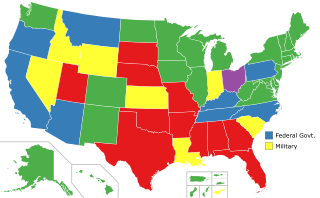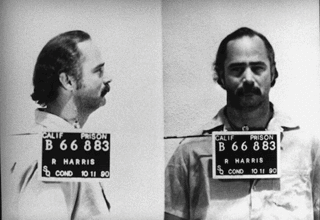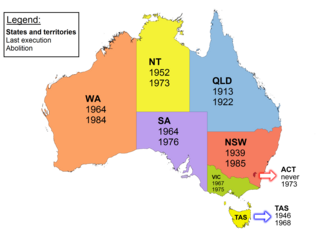Notes and references
Notes
- ↑ Slave trading was assimilated to piracy, as hostis humani generis .
- ↑ John Conn and four other persons were executed for treason on 1862 in Texas, under Confederate authority.
- ↑ On 1801, soldier Jose Antonio Rosas was shot for sodomy in Spanish California.
- ↑ 17 Native Americans, 13 Filipinos, 8 Chinese and 2 Japanese.
- ↑ Native Americans.
- ↑ Two executions for bank robberies causing death (Tony Chebatoris and James Dalhover) included here.
- ↑ Julius and Ethel Rosenberg.
Related Research Articles

A gas chamber is an apparatus for killing humans or other animals with gas, consisting of a sealed chamber into which a poisonous or asphyxiant gas is introduced. Poisonous agents used include hydrogen cyanide and carbon monoxide.

In the United States, capital punishment is a legal penalty throughout the country at the federal level, in 27 states, and in American Samoa. It is also a legal penalty for some military offenses. Capital punishment has been abolished in 23 states and in the federal capital, Washington, D.C. It is usually applied for only the most serious crimes, such as aggravated murder. Although it is a legal penalty in 27 states, 20 states currently have the ability to execute death sentences, with the other seven, as well as the federal government, being subject to different types of moratoriums.

In the U.S. state of California, capital punishment is not allowed to be carried out as of March 2019, because executions were halted by an official moratorium ordered by Governor Gavin Newsom. Before the moratorium, executions had been frozen by a federal court order since 2006, and the litigation resulting in the court order has been on hold since the promulgation of the moratorium. Thus, there will be a court-ordered moratorium on executions after the termination of Newsom's moratorium if capital punishment remains a legal penalty in California by then.

Capital punishment is a legal penalty in the U.S. state of Ohio, although all executions have been suspended indefinitely by Governor Mike DeWine until a replacement for lethal injection is chosen by the Ohio General Assembly. The last execution in the state was in July 2018, when Robert J. Van Hook was executed via lethal injection for murder.

Robert Alton Harris was an American car thief, burglar, kidnapper and murderer who was executed at San Quentin State Prison in 1992 for the 1978 murders of two teenage boys in San Diego. His execution was the first in the state of California since 1967.

Caryl Whittier Chessman was a convicted robber, kidnapper and serial rapist who was sentenced to death for a series of crimes committed in January 1948 in the Los Angeles area. Chessman was charged with 17 counts and convicted under a loosely interpreted "Little Lindbergh law" – later repealed, but not retroactively – that defined kidnapping as a capital offense under certain circumstances. His case attracted worldwide attention, and helped propel the movement to end the use of capital punishment in the state of California.
Yellow Mama is the electric chair of the U.S. state of Alabama. It was used for executions from 1927 to 2002.
The People of the State of California v. Robert Page Anderson, 493 P.2d 880, 6 Cal. 3d 628, was a landmark case in the state of California that outlawed capital punishment for nine months until the enactment of a constitutional amendment reinstating it, Proposition 17.

Capital punishment in Australia has been abolished in all jurisdictions since 1985. Queensland abolished the death penalty in 1922. Tasmania did the same in 1968. The Commonwealth abolished the death penalty in 1973, with application also in the Australian Capital Territory and the Northern Territory. Victoria did so in 1975, South Australia in 1976, and Western Australia in 1984. New South Wales abolished the death penalty for murder in 1955, and for all crimes in 1985. In 2010, the Commonwealth Parliament passed legislation prohibiting the re-establishment of capital punishment by any state or territory. Australian law prohibits the extradition or deportation of a prisoner to another jurisdiction if they could be sentenced to death for any crime.
Capital punishment for juveniles in the United States existed until March 2, 2005, when the U.S. Supreme Court ruled it unconstitutional in Roper v. Simmons. Prior to Roper, there were 71 people on death row in the United States for crimes committed as juveniles.

Capital punishment in Alabama is a legal penalty. Alabama has the highest per capita capital sentencing rate in the United States. In some years, its courts impose more death sentences than Texas, a state that has a population five times as large. However, Texas has a higher rate of executions both in absolute terms and per capita.
In the state of California, a heavily modified version of the common law felony murder rule is codified in California Penal Code § 189.
Capital punishment in New Jersey is currently abolished, after Governor of New Jersey Jon Corzine signed a law repealing it in 2007. Before this, capital punishment was used and at least 361 people have been executed.
Capital punishment is a legal penalty in the U.S. state of North Carolina.
Brian Keith Baldwin was an African-American man from Charlotte, North Carolina, United States of America, who was executed in 1999 in Alabama. Many believe that he was wrongfully convicted and sentenced for the 1977 murder of a young white woman in Monroe County of that state. The only evidence against Baldwin in the murder was his own confession, which he later retracted. He said that it was coerced by the local police in Wilcox County, Alabama, where he was arrested; they beat and tortured him under interrogation. A 1985 letter by his co-defendant Edward Dean Horsley surfaced in 1996, after Horsley had been executed for first-degree murder in the case. He wrote that he had acted alone in the rape and murder of Naomi Rolon, and that Baldwin had not known of her death.

Doyle Lee Hamm was an American death row inmate in Alabama, who was convicted and sentenced to death for the 1987 murder of Patrick Cunningham, whom he killed while committing a robbery. While on death row, Hamm developed lymphatic cancer, which made it difficult to impossible to achieve the venous access necessary to administer the drugs used in lethal injections. Despite months of warning by Hamm's attorney and human rights observers and a decades' long legal battle, the Alabama Department of Corrections attempted to execute Hamm on February 22, 2018. The unsuccessful execution attempt lasted nearly three hours and drew international attention. In March 2018, Hamm and the state of Alabama reached a confidential settlement, the terms of which precluded a second execution attempt, giving Hamm a de facto sentence of life in prison without the possibility of parole, although his sentence was not formally commuted. Hamm remained in prison until his death from cancer-related complications in 2021.
James Emery Paster and Stephen Albert McCoy were American serial killers who murdered at least three people in Texas between 1980 and 1981. Both were sentenced to death and executed at the Huntsville Unit in Huntsville, Texas, via lethal injection. Prior to Emery's execution, he confessed to two other murders in the Houston area, but he was never tried for either of these killings. McCoy was executed in May 1989, in what was considered a botched execution. Emery was executed in September 1989.
References
- ↑ Supreme Court to hear case on death penalty restriction, Los Angeles Times, David G. Savage, January 05, 2008
- ↑ "Coburn". Alabama Journal. 1964-06-08. p. 11. Retrieved 2022-04-18.
- ↑ "RAPE WHERE VICTIM LIVED". May 12, 2009. Archived from the original on 2009-05-12. Retrieved December 1, 2011.
- ↑ "People v. Wright, 55 Cal.2d 560".
- ↑ United States Demographics, Part B
- ↑ "People v. Monk, 56 Cal.2d 288".
- ↑ "Paul V. Coates – Confidential File, April 27, 1960". 2010-04-27. Retrieved 2019-02-04.
- ↑ "More on Capital Punishment". MarshallsKnowledge©. 2016-10-24. Retrieved 2019-02-04.
- ↑ "San Quentin Gas Chamber Claims Life of Billy Monk". Valley News. November 23, 1961. p. 19.
- ↑ "Man's Life Taken for Rape Attempt". Charlotte News. 22 November 1957.
- ↑ 100 S.E.2d 249 (N.C. 1957); 247 N.C. 98; STATE v. Ross McAFEE (alias J. C. Adams). No. 361, Supreme Court of North Carolina. November 6, 1957.
- ↑ Berger, Peter L. (2011-06-07). Adventures of an Accidental Sociologist: How to Explain the World Without Becoming a Bore. Prometheus Books. p. 40. ISBN 978-1-61614-390-9.
- ↑ Christianson, Scott (2010). The Last Gasp: The Rise and Fall of the American Gas Chamber. University of California Press. ISBN 978-0-520-25562-3.
- ↑ "The Sad Story of Private Eddie Slovik". 28-110-k.org. Archived from the original on January 7, 2010. Retrieved December 1, 2011.
- ↑ "Negro Is First To Die For Night Burglary". The Tuscaloosa News . August 8, 1941. p. 2. Retrieved August 27, 2013.
- ↑ "Alabama executes Negro for burglary". Monroe News Star Newspaper. August 8, 1941. Retrieved February 4, 2018.
- ↑ "First Burglar Goes To Chair Under New Death Penalty Law". The Montgomery Advertiser. 1941-08-08. p. 1. Retrieved 2019-02-04.
- ↑ "Alabama Negro To Die For Night Burglary". The Palm Beach Post. 1941-08-08. p. 8. Retrieved May 26, 2021.
- ↑ Chambless, Ann B. (November 11, 2011). "A story back in time". The Daily Sentinel. Retrieved August 27, 2013.
- ↑ O'Shea, Kathleen A. (1994). "Till death do us part" (PDF). Nemesis. 10 (2): 54.
- ↑ Berry, Irene; O'Hare, Sheila and Silva, Jesse (2006). Legal Executions in California: A Comprehensive Registry, 1851–2005. McFarland & Company, Inc., Publishers, p. 61.
- ↑ Berry, Irene; O'Hare, Sheila and Silva, Jesse (2006). Legal Executions in California: A Comprehensive Registry, 1851–2005. McFarland & Company, Inc., Publishers, p. 10.
- ↑ Niles' National Register. Vol. 23. January 4, 1823. p. 288.
- ↑ Manion, Jen (2015-10-07). Liberty's Prisoners: Carceral Culture in Early America. University of Pennsylvania Press. ISBN 978-0-8122-9242-8.
- ↑ Gutierrez, Ramon A.; Almaguer, Tomas (2016-08-23). The New Latino Studies Reader: A Twenty-First-Century Perspective. Univ of California Press. p. 422. ISBN 978-0-520-28484-5.
- ↑ "Bathsheba Spooner, Hannah Piggen, and Rachel Wall". Tattered Fabric: Fall River's Lizzie Borden. 2008-08-11. Archived from the original on 2015-10-19.
- ↑ "Mary Latham Marries an Older Man – And Regrets It - New England Historical Society". www.newenglandhistoricalsociety.com. 16 March 2015. Retrieved 2020-06-22.
- ↑ United States Congress House Committee on the Judiciary Subcommittee No. 3 (1972). Capital punishment. Hearings, Ninety-second Congress, second session. Boston Public Library. Washington, U.S. Govt. Print. Off. pp. 265.
{{cite book}}: CS1 maint: numeric names: authors list (link)